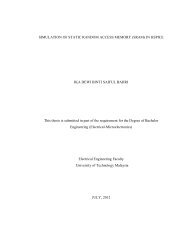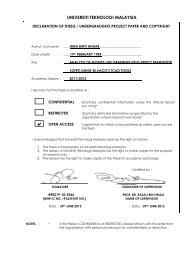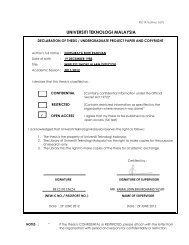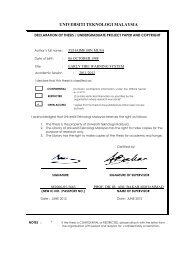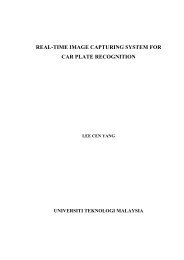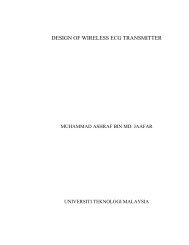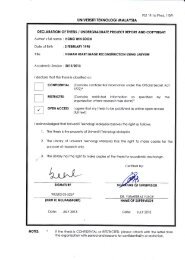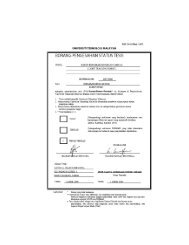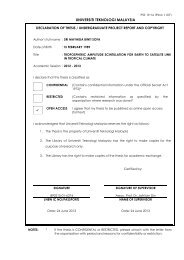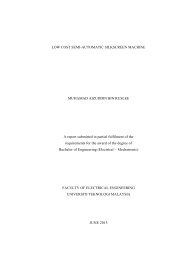micromouse maze solving robot chang yuen chung universiti ...
micromouse maze solving robot chang yuen chung universiti ...
micromouse maze solving robot chang yuen chung universiti ...
Create successful ePaper yourself
Turn your PDF publications into a flip-book with our unique Google optimized e-Paper software.
ii“I declare that this thesis entitled “Micromouse – Maze Solving Robot” is the resultof my own research except as cited in the references. The thesis has not beenaccepted for any degree and is not concurrently submitted in candidature of anydegree”.Signature :Name : CHANG YUEN CHUNGDate : MAY 2009
iiiDEDICATIONSpecially to my belovedparents, siblings and friendsfor their eternal support, encouragementand inspiration throughoutmy journey of education.
ivACKNOWLEDGEMENTI would like to take this opportunity to express my deepest gratitude to myproject supervisor, Assoc. Prof. Dr. Mohamad Noh Ahmad who has given meguidance throughout the entire project. It would be difficult for me to complete thisproject without his guidance and support.Beside, I would like to thanks my family member for giving the spirit alongwith the supporting assisting my project. Their blessings were the main effort for me tohandle the obstacle I will be facing.I would also like to express my deepest gratitude to my friends, especially toall my course mates who have given me help technically and mentally during theaccomplishment of this project. Lastly also to the technicians of the laboratory,without their guidance and patience, my work could not flow smooth. Thank you allfor the technical advices, moral support and ideas to enhance my project. Thank you.
vABSTACTThe IEEE <strong>micromouse</strong> competition has been a popular event amongengineering students and engineers. A <strong>micromouse</strong> is an autonomous vehicle whoseobjective is to find the centre of an unknown <strong>maze</strong>. This thesis summarizes thedesign and implementation of the <strong>micromouse</strong> for the UTM final year project ofsemester 2008/2009. The design method of the <strong>micromouse</strong> project consisted of twostages. The first stage was to design and construct individual system. The secondstage of the design process was to interface the systems to form the final prototype.The individual components of <strong>micromouse</strong> system consist of the motor controlsystem, navigation sensor array, and a mapping system or algorithm for navigatingthe <strong>maze</strong> intelligently. A 7x7 cell <strong>maze</strong> was developed in order to validate the overallperformance of the <strong>micromouse</strong>. As a result of the whole project, the <strong>micromouse</strong>will eventually move to the centre of the <strong>maze</strong> without external help and manage tofind the shortest path from the mapping system after navigating all the possible pathin the <strong>maze</strong>.
viiTABLE OF CONTENTSCHAPTER TITLE PAGEDECLARATIONiiDEDICATIONACKNOWLEDGEMENTABSTRACTABSTRAKTABLE OF CONTENTSLIST OF FIGURESLIST OF SYMBOLS AND ABBREVIATIONSLIST OF APPENDICESiiiIvvviviiixxixii1 INTRODUCTION 11.1 Project Background 11.2 Problem Statement 21.3 Objectives and Project Scope21.4 Thesis Layout32 LITERATURE REVIEW 42.1 Preview 42.2 Dexter 52.3 Mobot 62.4 Micromouse FYP UTM 2006 72.5 Micromouse FYP UTM 200682.6 Overview92.7 Summary10
viii3 METHODOLOGY 113.1 Overview of Micromouse Function andTheory113.2 Project Flow Out133.3 Structure and Mechanism 143.4 Hardware and Components 143.5 Circuit Design 173.6 Algorithm193.7 Summary244 RESULT AND ACHIEVEMENT 254.1 Hardware and Structure 254.2 Electronics 274.3 Maze Field 304.4 Algorithm314.5 Summary335 DISCUSSION AND CONCLUSION 355.1 Discussion 355.2 Conclusion 365.3 Suggestions And Future Development 37REFERENCES 38APPENDICESAppendix A Gantt Chart 39
ixLIST OF FIGURESFIGURE NO. TITLE PAGE2.1 Dexter 52.2 Mobot 62.3 Micromouse UTM FYP 2006 72.4 Micromouse UTM FYP 2006 82.5 First Draft Design 103.1 Flowchart of the Sub Stages for the Project 133.2 3D Lookup for the Micromouse 143.3 Stepper Motors 153.4 Analog Distance Sensor 153.5 Lithium Polymer Battery 163.6 Castor 163.7 LCD Display 173.8 PIC18F452 183.9 UCN5804 183.103.11Connection of the Motor Board with Stepper MotorPictorial Illustrations for Modified Flood FillAlgorithm19224.1 Views of the Micromouse 264.2 Top view of Main Board 274.3 Schematic for the Main Board 284.4 Top View of the Motor Board 294.5 Schematic for the Motor Board 304.6 The Different Type of Maze Made By the RandomizeMaze 314.7 Information Byte 32
x4.8 Memory Structure of A Stack Pointer 324.9 A View of the EEPROM Memory Using MPLAB 334.10 View of Micromouse Moving in the Maze 34
xiLIST OF ABBREVIATIONS3D - 3 DimensionADC - Analogue to Digital ConverterCm - CentimeterDC - Direct CurrentIO - Input OutputLCD - Liquid Crystal DisplayPCB - Printed Circuit BoardIEEE - Institute of Electrical and Electronics Engineering
xiiLIST OF APPENDICESAPPENDIX TITLE PAGEA Gantt Chart Semester 1 and 2 39
CHAPTER 1INTRODUCTION1.1 Project BackgroundThe Micromouse is an autonomous <strong>robot</strong> whose goal is to find the center of a<strong>maze</strong>. In 1977, the IEEE Spectrum Magazine first introduced the idea of theautonomous Micromouse <strong>robot</strong> as a <strong>maze</strong> <strong>solving</strong> device. Soon after, the first IEEEAmazing Micromouse Maze Contest was held in New York in June 1979. Out ofover 6000 entries received, fifteen Micromouse competed, from which the eventualwinner was Moonlight Flash, a non-intelligent wall follower mouse.Popularity of the Micromouse grew from there, and competitions were soonheld all around the world. The first European competition took place in London 1980,and the first world Micromouse competition, open to contestants from across Europeand the United States, was held in Tsukuba, Japan in August 1985. From the early1990s, Micromouse club started to appear in school and <strong>universiti</strong>es around theworld. The IEEE Micromouse competition now enjoys great popularity amongundergraduate and graduate student from various organization around the globe.Micromouse has undergone an astounding metamorphosis in the last severaldecades. Early Micromouse was far less technologically and electronically advancedcompared to those today. Moonlight Flash, the winner in 1979, was a crudemechanical mouse that simply employed a feeler along the walls to navigate its wayto the goal. Moreover, several of the other mouse at the competition did not includemicroprocessors in their design, instead opting to use simple IC logic. The top motor
3<strong>solving</strong> algorithm to the center of the Maze and the size of the Maze will be 49 cellswith 18cm x 18cm each. It will also avoid colliding with the <strong>maze</strong> walls byautomatic balancing system and performing all the basic smooth movement whichare straight, clockwise or anticlockwise 90 degree turning and also 180 degreeturning.On the wider scope of accomplishment, Micromouse project is hope to play arole in linking the builder with a great aspect in engineering knowledge since itinvolve in lots of element such as design, control, analysis and others.1.4 Thesis LayoutThis thesis consist of five chapters and after the chapter one about theintroduction, chapter two will be the literature review section which was done to gaina clear view and knowledge to this project. So, few existing model of Micromousewill be discussed in this section as a guide for the project.Chapter three will be the Methodology section which will discuss all thecomponents and methods for building the Micromouse. All the results andachievements for the project will be stated in chapter four and lastly for chapter fivewill be the discussion and conclusion for the project.
CHAPTER 2LITERATURE REVIEW2.1 PreviewBefore any development can take place, a research must be carried outon all the possible components that will be used in the Micromouse. Most of theresearches were carried out through the web. Beside of the internet resources, thethesis room in FKE also provides some thesis reference from the previous final yearproject student. Another good source of information is the competitions themselves.Much can be learned by emailing and questioning other teams about issues theyexperienced while developing their Micromouse. Only then, issues such asmicrocontroller, chassis design, wheel layout, and sensor placement are to be decided.This is perhaps the most critical design phase, which will affect the rest of the project.There were four existing Micromouse model which had lead to the designprocess. Each models’ specification were analyzed and being categorized intoadvantages and disadvantages for reference. The advantages each model provideswill be implemented in the project if necessary.
52.2 Dexter [1]The first literature review is the Micromouse <strong>robot</strong> named Dexter which isdepicted from the internet resources. Dexter was a <strong>micromouse</strong> created by SteveBenkovic with his senior competing in a <strong>micromouse</strong> competition. This <strong>robot</strong> usedMotorola 68Hc11 as its controller along with a 32k backed battery memory RAM forreplacing the insufficient memory space. The actuator used was two mini steppermotor and was drive by an Allegro stepper motor driver and 8AAA batteries. The<strong>robot</strong> uses 11 IR sensors and the design was based on wheel chair design while thepackaging was mounted by acrylic casing. The other sub components that includedinto Dexter’s’ design were plastic wheels and LCD display as information viewer fordebugging and testing the performance while exploring in the Maze since in realitycant direct find out the error that shown by the software instruction and just can beview through the assistance of the LCD display. As been informed, this Micromousemanaged to solve the <strong>maze</strong> in the competition using the algorithm but it did not madethe fastest time to arrive the center of the <strong>maze</strong> but the design on the hardware partwas a great deal. Figure 2.1 shows the frame for Dexter.Figure 2.1 Dexter [1]
62.3 Mobot [2]The second model will is Mobot which was created by an Indian studentnamed Mohit Bhoit. PIC18F452 with large memory was used in the <strong>robot</strong> ascontroller. This <strong>robot</strong> used 4 IR sensors and two unipolar stepper motors along withUCN5804 motor driver. The power supply came from 10AAA Ni-Cd cells and thebased was formed by aluminium and mechano base plate. The wheel was createdusing aluminium steel which mounted by rubber.The controller provides enough memory to perform with the algorithm. Themotor driver being used is quite simple in the connection with the stepper motor interms of the schematic. Meanwhile, the idea for the wheel covered using rubber is agood idea to prevent the wheel from slipping while performing the task and affect theperformance of the <strong>robot</strong>. Figure 2.2 shows the view of Mobot.Figure 2.2 Mobot [2]
72.4 Micromouse UTM FYP 2006 [3]This version of Micromouse was built by Louis Wong Siang San. Thecontroller used was PIC16F627. Louis used PCB circuit for the circuit design, IRsensors, 2 stepper motors drive with darlington array IC and powered by externalpower supply. The base was formed by wooden plank base and small castorsupporting with two wooden wheels.This model of Micromouse also used a microcontroller that providessufficient memory for the algorithm. The circuit board is formed by PCB boardwhich in this case the <strong>robot</strong> circuit will look more neat and the avoidance fromcircuit failure in terms of connection lose like jumper or else since in reality most ofthe circuits board not made by PCB board need a lot of jumper to link the connection.Figure 2.3 shows the view for this Micromouse <strong>robot</strong>.Figure 2.3 Micromouse UTM FYP 2006 [3]
82.5 Micromouse UTM FYP 2006 [4]Another version of <strong>micromouse</strong> was builded also by student UTM in FYP2006. This Micromouse was built by Indran A/L Thandavarian. This <strong>robot</strong> usedMotorola MC68HC11E as controller with two stepper motors, whisker sensor and IRsensors. The base for the <strong>robot</strong> was formed by aluminium chasis with a big chasis assupporting.This <strong>robot</strong> actually is not very good in terms of the design. The overall size isvery big in terms of the castor and the body of the <strong>robot</strong> compared to the othermodel. The circuit arrangement is very messy in terms of the jumper and it is quite adangerous design in terms of the circuit layout. The special area for this <strong>robot</strong> is thesensor it implemented in it, beside of IR sensor it uses also whisker sensor. Thisbrings the idea of another communicating way for the <strong>robot</strong> with the environment.Figure 2.4 shows the build up for this Micromouse.Figure 2.4 Micromouse UTM FYP 2006 [4]
92.6 OverviewFrom the four model of Micromouse that had been discussed, each model’sspecification was categorized in terms of advantages and disadvantages. The reasonfor categorizing was to make as a reference to lead the project design. Each model’sadvantages and disadvantages were shown in below.DexterAdvantages: Good Arrangement, Good StructureDisadvantages: Large Battery Pack, Complex Circuit, Memory Small, PlasticWheelMobotAdvantages: Circuit Simple, Good Arrangement and Structure, EasyProgramming with Enough Memory, Rubber Mounted WheelDisadvantages: Large Battery PackMicromouse (Louis Wong Siang San)Advantages: Small Size, Good Arrangement with Circuit, Simple Circuit, EasyProgramming with Enough MemoryDisadvantages: Large Battery Pack, Wooden Wheel, Castor Balancing NotGoodMicromouse (Indran A/L Thandavarian)Advantages: Rubber WheelDisadvantages: Bad Circuit Arrangement
102.7 SummaryAs a summary from the literature review section, additional knowledge hadbeen gained in the design of the Micromouse and will include components listedbelow.1. 2 stepper motor and 3 analog distance sensors will be used2. PIC as controller with c language3. Wheel mounted with rubber so not easily slippery4. Using layer of circuit to minimize circuit size5. Acrylic casing6. Battery with small size and last longing7. Wheel chair design supporting with castorA simple 3D sketch up shown in Figure 2.5 was done in order to show thebasic structure for the Micromouse.Figure 2.5 First Draft Design
CHAPTER 3METHODOLOGY3.1 Overview of Micromouse Function and TheoryThere are two fundamental phases to the design process. The firstphase was to design individual components of the Micromouse and get them tooperate according to individual specifications independent of one another. Thesecond phase was to interface the individual components and have the Micromouseoperate as one autonomous unit. The first semester of the project was dedicated toworking on the individual components. The goal of the second semester was tointegrate the individual components. The individual working components include thenavigation sensor array, mapping algorithm, motor control, and chassis design. Aneffective Micromouse design must be able to meet the following functions in order tofind the center of a <strong>maze</strong>.a) Recognize walls and openingsb) Stay centered within each cellc) Know position and bearing within the <strong>maze</strong>d) Control the distance needed to travele) Make precise 45° and 90° turnsf) Good chassis to keep structure stableg) Navigate the <strong>maze</strong> intelligently
12As an overview of the Micromouse function, the mouse must recognize wallsand openings in order to navigate the <strong>maze</strong> and prevent crashes. The navigationsensor array provides the mouse with this information. The navigation sensor arrayconsists of a combination of three analog distance sensor situated in the left, rightand front of the Micromouse. The mouse must stay centered within the <strong>maze</strong> toprevent compounding errors in distance and position calculations. The left and rightsensors determine if it deviates from its desired bearing. This information is sent tothe motor control system to make proper corrections, either speeding up or slowingdown one wheel. The motor control portion of the project is responsible for safelymoving the Micromouse through the <strong>maze</strong>.The mouse must keep track of position and bearing during each run toprovide navigation information to the mapping system. The algorithm will calculatethe distance the Micromouse travels. The bit 4 and 5 in the information bytedetermines which direction the Micromouse is facing. The combination of these twosystems provides the data needed by the mapping and navigation systems.To move efficiently through the <strong>maze</strong> the Micromouse must be able to makeprecise clockwise or anticlockwise 90° turns and 180° turns. The mechanicalsoundness of the Micromouse design is an important factor. The chassis needs tokeep the systems stable during operation so accurate data is recorded. The chassisalso keeps the drive train in line in order to reduce the number of path correctionsmade. To successfully and efficiently solve the <strong>maze</strong> the mouse must makeintelligent navigation decisions based on its current position. The mapping systemutilizes a modified flood-fill algorithm to determine the best solution as the <strong>maze</strong> isdiscovered.
133.2 Project Flow OutAs stated in the abstract section, the project consists of two stages. Stage onewill be focusing on the development of individual system such as motor controlsystem and the navigation system. Second stage of the project was to interface theindividual systems to perform with each other as a whole system. Each stage can beseparate into sub stages that will link the whole project development. Figure 3.1shows the flowchart of the sub stages for the overall project.Figure 3.1 Flowchart of the Sub Stages for the Project
143.3 Structure and MechanismIn order to build the structure and the base for the Micromouse, a 3D sketchup had been performed by using the Solidwork software. Figure 3.2 shows the front,back and side view for the Micromouse.Figure 3.2 3D Lookup for the Micromouse3.4 Hardware and ComponentsIn this section, the individual working components on the hardware part willbe briefly described. The individual working components that will be described arestepper motors, analog distance sensor, castor, batteries and LCD display. Eachcomponent plays a role in assisting the system to perform the task.
153.4.1 Stepper MotorsFigure 3.3 Stepper MotorsStepper motors have been chosen as the actuators for the <strong>robot</strong> because of thestepping effect of the motor. This can easily for counting the movement for the <strong>robot</strong>in terms of distance inside the <strong>maze</strong>. Two units of LINIX 42BYGHD439 steppermotors will be used with hold torque of 2.5kg.cm and step angle of 1.8 degree/step.Figure 3.3 shows a pair of stepper motors being used in the project.3.4.2 SensorsFigure 3.4 Analog Distance SensorSensor was like the eye for the <strong>robot</strong> and it is important when exploring forthe <strong>maze</strong>. Research found that using normal IR sensor might cause problem whileexploring the <strong>maze</strong> due to the environment infrared intensity. So in order to avoidthis problem, analog distance sensor had been chosen. This sensor had been choosebecause it can only receive the signal with frequency emit by it own self without alter
16by the environment. Figure 3.4 shows the analog distance sensor being used in theproject.3.4.3 BatteryFigure 3.5 Lithium Polymer BatteryWhile choosing the battery, the weight and the lifetime of the <strong>robot</strong> had beenconsidered. Normally battery with long lifetime will had a big size and weight whilesmall size will had low lifetime. So after consideration, lithium polymer battery willbe chosen since its size is small and long lifetime. The rating for the battery will be11.1v with 1300mAh. The disadvantage for this kind of battery was only the pricequite high. Figure 3.5 shows a view of the lithium polymer battery.3.4.4 CastorFigure 3.6 CastorFigure 3.6 shows a castor that was used as the balancing point or supportingfor the <strong>robot</strong> base. The base basically consists of the two stepper motor mounted byacrylic but will not balance so the castor was implement to provide the balancing.
173.4.5 LCD DisplayFigure 3.7 LCD DisplayLCD Display was used as an error debugging tools for displaying theinformation we wished to see from the system. Figure 3.7 show a 16x2 LCD displaythat was used in the project.3.5 Circuit DesignThe circuit development for Micromouse will be consists of the main boardand motor board. Both of the boards will combine with the other hardwarecomponents to work as a system.3.5.1 Main BoardThe main board can be considered as the brain for the <strong>robot</strong> since it consistthe PIC18F452 microcontroller. Figure 3.8 shows the characteristic tables and pindiagram for PIC18F452. Beside of the microcontroller, the board consist all the othercomponents such as the voltage regulator, pin connection to the power supply,connection to the motor board, sensors connection, and other basic electroniccomponents. The main board can considered as the main control unit for the <strong>robot</strong>since all the signals processing will be done on this board.
18Figure 3.8 Characteristic Table and Pin Diagram for PIC18F4523.5.2 Motor BoardFigure 3.9 UCN5804Motor board was used to control the high voltage and current to the steppermotor since the microcontroller not affordable to supply high voltage and current tothe motor. Motor board was mainly consisting of the UCN5804 unipolar steppermotor driver which shown in Figure 3.9. The driver will receive signal from the PICand operate the motor to move or either stop. The basic connection idea for the motorboard is shown in Figure 3.10.
19Figure 3.10 Connection of the Motor Board with Stepper Motor3.6 AlgorithmThe principle goal of the Micromouse is to solve the <strong>maze</strong> and find itscenter as quickly as possible. To accomplish this task, the Micromouse uses aparticular <strong>maze</strong> searching algorithm.A vast amount of research on searching techniques already exists and iscurrently being undertaken. Mathematicians in the fields of topology and graphtheory have been studying <strong>maze</strong> creation and <strong>maze</strong> <strong>solving</strong> algorithms for severalcenturies. However, the algorithms they have developed area not feasible forMicromouse applications due to the memory and speed limitations of mostMicromouse microcontrollers. Moreover, since searching through data is afundamental function of computers, computer scientists have also devised a numberof different searching techniques throughout the last few decades. Again, while thesealgorithms are highly effective and efficient for computers built with sophisticatedmicroprocessing unit, they cannot practically implement in the less advanced
20microcontrollers utilized for Micromouse. As a result, Micromouse <strong>robot</strong> generallyuses some variation of the following search algorithms: Wall Following, Depth FirstSearch, and Flood Fill.Wall Following is a trivial algorithm in which the mouse chooses a wall,either left or right, and then always keep the chosen wall on its side as it movesthrough the <strong>maze</strong>. This algorithm is very simple to implement in code, butunfortunately it is inefficient and does not work for IEEE <strong>maze</strong>s because they arespecially designed to prevent Wall Following mice from succeeding.Depth First Search is an intuitive algorithm for searching a <strong>maze</strong> in which themouse first starts moving forward and randomly chooses a path when it comes to anintersection. If that path leads to a dead end, the mouse returns to the intersection andchoose another path. This algorithm forces the mouse to explore each possible pathwithin the <strong>maze</strong>, and by exploring every cell, the mouse eventually finds the center.It is called “depth first” because, if the <strong>maze</strong> is considered a spanning tree,the full depth of one branch is searched before moving onto the next branch. Therelative advantage of this method is that the Micromouse always find the route.Unfortunately, the major drawback is that the mouse does not necessarily find theshortest or quickest route, and it wastes too much time exploring the entire <strong>maze</strong>.Flood Fill is better suited to the Micromouse than the two algorithmsdiscussed above. This algorithm, also known as Bellman’s algorithm, uses asophisticated system of distance and wall information to refine a short path to thecenter of the <strong>maze</strong>. Since the <strong>maze</strong> has a fixed size already known to theMicromouse, it must first assign a value to each cell in the <strong>maze</strong> representing thedistance from that cell to the center and store these values in an array. TheMicromouse must also store a wall map which will be continually updated withinformation as the sensors detect new walls in the <strong>maze</strong>. At each cell, theMicromouse performs the following steps:
211. Check for new walls and update the wall map.2. “Re-flood” the <strong>maze</strong> with new distance values and update the distancearray.3. Move to the neighbouring cell with the lowest distance value.Flood Fill is called a “breadth first” algorithm because, if the <strong>maze</strong> isconsidered to be a spanning tree, an entire level is searched before exploring thewhole depth of a particular branch. The major advantage of the Flood Fill algorithmis that it always finds the shortest path to the center of the <strong>maze</strong>. It is important tonote that the shortest path is not necessarily the quickest path since a path filled withturns will take a longer time to traverse than one primarily composed of forwardgoing moves. The relative disadvantage of this algorithm is that more memoryrequired for execution.Several modifications of the flood filled algorithm may be implemented toincrease efficiency. For example, Modified Flood Fill is a derived version of regularFlood Fill in which only those valued which need to be <strong>chang</strong>ed are actually updatedwhen searching the <strong>maze</strong> rather than re-flooding the entire <strong>maze</strong> as in regular FloodFill. This method is considerably faster than regular Flood Fill because entire <strong>maze</strong>does not need to update each time the Micromouse moves to a new cell.Flood Fill algorithm will be developed in this project since it is the mosteffective algorithm among the algorithms been explained. The Modified Flood Fillalgorithm will also be carried out from the modification of Flood Fill algorithm.Figure 3.11a and 3.11b shows the pictorial illustrations for Modified Flood FillAlgorithm:
Figure 3.11a Pictorial Illustrations for Modified Flood Fill Algorithm22
Figure 3.11b Pictorial Illustrations for Modified Flood Fill Algorithm23
243.7 SummaryAs a summary for chapter 3, the whole Micromouse architecture had beenplan out. The hardware design, circuits design and algorithm had been predefined sothe progress will just follow as shown in the flow chart in Figure 3.1. Good timemanagement should also be alert since this project involves a lot of work such assystem built up, testing, modification and documentation. So, time management canalso be considered as an element of methodology.
CHAPTER 4RESULT AND ARCHIEVEMENT4.1 Hardware and StructureFigure 4.1 shows the mechanism and structure for the Micromouse beingbuilt. The base of the <strong>robot</strong> was formed by acrylic casing that holds the stepper motor.The base was supported by the two wheels made by PE rode and a castor. Thewheels were covered with rubber stripe to prevent against slippery while navigatingin the <strong>maze</strong>.Meanwhile, the upper part of the Micromouse was formed by the two layer ofcircuit arrangement which is the main and motor boards. The sensors were attachedon the front, left and right of the <strong>robot</strong>. The battery was located at the middle of the<strong>robot</strong> to form the center of the mass and supported by the castor and the base of the<strong>robot</strong>. Circuit connectors were made to link the board and other components togetherto work as w system. Overall, the <strong>robot</strong> weight was around 0.7 kg, height of 13 cm,length of 13 cm and the width of 8.7 cm.
26Right ViewLeft ViewVIEWFront ViewRear ViewFigure 4.1: Views of the Micromouse
274.2 ElectronicsAs stated in the methodology part, the electronics circuit consists of two partswhich is the main board and motor board for the purpose of neat arrangement. Thecircuit will link to each other and also other components using connector to performas multi stages system.4.2.1 Main BoardAs mentioned before, the main board is the processing unit for the whole<strong>robot</strong>. The board consists mainly of the microcontroller PIC18F452, voltageregulator, switches, connectors to motor boards, sensors connectors, connection fromthe power supply and others. The main task of the main board is to receiveinformation from the sensors and passed to the algorithm for decision making. Theoutcome signals will be send to the motor board as reaction of movement. Besidethat, main board is also the center of power supply to the other components andmotor board. Figure 4.2 shows the view of the main board and Figure 4.3 shows theschematic for the main board connection.Figure 4.2 Top View of Main Board
281234+5VVCC VCC VCC VCCABSENSOR321Header 3+5V1 23456 7891 0ICSPHeader 5X2AS?SW-PBOSC1LED1LED2LED3LED4R110KPIC113OSC1/CLKI1MCLR/VPP2RA0/AN03RA1/AN14RA2/AN25RA3/AN3/VREF6RA4/T0CKI7RA5/SS/AN433RB0/INT34RB135RB236RB337RB438RB539RB640RB712VSS31VSSPIC18F452VDDVDDOSC2/CLKORC0/T1OSI/T1CKIRC1/T1OSI/CCP2RC2/CCP1RC3/SCK/SCLRC4/SDI/SDARC5/SDORC6/TX/CKRC7/RX/DTRD0/PSP0RD1/PSP1RD2/PSP2RD3/PSP3RD4/PSP4RD5/PSP5RD6/PSP6RD7/PSP7RE0/RD/AN5RE1/WR/AN6RE2/CS/AN7113214151617182324252619202122272829308910OSC2TXRXBUTTON1BUTTON2BUTTON3BUTTON4B U T T O N 1R?Res11KS1SW-PBLED1LED2LED3LED4B U T T O N 2R?Res11KR?S2SW-PBRes11KR?Res11KR?Res11KR?Res11KB U T T O N 3LED1LED1LED1LED1R?Res11KS3SW-PBB U T T O N 4R?Res11KS4SW-PBABVCCCVCCCC1Cap Semi30pFC2Cap Semi30pF1 2OSC1Y1XTALOSC2S? 321SW-SPDTF?Fuse 1D1Diode 1N4007D2C40.1uFDiode 1N4007C2100uFLM7805Vin VoutGNDC1100uFC30.1uFR?330LED2DTitleD12SizeA3NumberDate: 10/31/2008 Sheet ofFile: C:\Documents and Settings\..\cyc.SchDoc Drawn By:4RevisionFigure 4.3 Schematic for the Main Board
294.2.2 Motor BoardFor the motor board, the circuit consists of the UCN5804 unipolar steppermotor driver, connectors to the main board and stepper motor, power resistor, diodesand capacitors. The main task for the motor board is to receive signals from the mainboard and send to the motor to control the movement of the <strong>robot</strong>. The view of themotor board is shown in Figure 4.4 while the schematic diagram for the motor boardis shown in Figure 4.5.Figure 4.4 Top View of Motor Board
30Figure 4.5 Schematic for the Motor Board4.3 Maze FieldThe <strong>maze</strong> field constructed for the Micromouse to operate is a <strong>maze</strong> with 49cells and each cell has dimension of 18cm x 18cm. The height of the <strong>maze</strong> is 18cm.The <strong>maze</strong> is a randomize <strong>maze</strong> which means the wall inside the <strong>maze</strong> can berandomly organized to any pattern as wished.The <strong>maze</strong> field was constructing mainly using “manila” cards andpolystyrene. Figure 4.6 shows the <strong>maze</strong> that been constructed.
31Figure 4.6 The Different Type of Maze Made By the Randomize Maze4.4 AlgorithmThe Flood fill and Modified Flood Fill algorithms have been successfullytested perfectly in the constructed randomized <strong>maze</strong> field. Both of the algorithm willalways find an alternative path to the center of the <strong>maze</strong> and after few rounds oftraveling, it will determine the shortest path to the center of the <strong>maze</strong>. ModifiedFlood Fill algorithm will be use as main <strong>solving</strong> algorithm since it takes less process.EEPROM had been used to memorize the <strong>maze</strong> map when exploring andassisting the effectiveness of the algorithm. Since there are 49 cells, so 49 byte willbe use to memorize the <strong>maze</strong> map. Each of the byte is called the information bytesince it stores the information for the map. Basically, each information byte consistof 8 bits where bit 0 to bit 3 will used to store the existence of wall in the North,West, East, South direction. Bit 4 and bit 5 will be used to keep the facing directionof the Micromouse in the current cell. The other left bit will not be used. Figure 4.7
32shows the content of the information byte while Figure 4.9 shows the view of theEEPROM using MPLAB. Beside of storing the map information, another 49 bytewas used to store the weight of each cell since also a part for the algorithm.Beside of the EEPROM, stack pointer is also used to assist the algorithm. Thestack pointer is used to store the cells which need to be checked by the algorithm.Figure 4.8 shows the memory structure of a stack pointer.7 6 5 4 3 2 1 0No Used Direction West South East North00-Facing North01-Facing South10-Facing East11-Facing WestFigure 4.7 Information ByteFigure 4.8: Memory Structure of A Stack Pointer
33Information ByteGoing WeightBacking WeightFigure 4.9: A View of the EEPROM Memory Using MPLAB4.5 SummaryThe overall achievements for the Micromouse project had been achievedbased on the objective and project scope listed in chapter 1 and 2. The mouse canperform the <strong>maze</strong> <strong>solving</strong> techniques using the algorithm. The mouse can makesmooth movements in straight, 90 degree turns and 180 degree turns.The randomly organized <strong>maze</strong> field had proved the efficiency of thealgorithm implement on the <strong>robot</strong>. All the other individual components such as thesensors, battery, stepper motors, LCD display and castor had also successfully playedtheir role as part of the system. The mechanism and structure for the <strong>robot</strong> work wellin terms of the stability of the <strong>robot</strong>.The objective for the electronic parts had been achieved since the main boardand the motor board link to each other to produce good interactive controllingprocess. Not much circuit debugging error had been encounter in the whole circuit
34development process. Figure 4.10 shows some of the view for the Micromousemoving in the <strong>maze</strong>.Figure 4.10 View of Micromouse Moving in the Maze
CHAPTER 5DISCUSSION AND CONCLUSION5.1 DiscussionBased on the achievement and respond from the lecturer and student, theMicromouse project is seen successfully achieve its project scope and objectives asdiscussed in chapter one. There is not much constraint occurs on the first stage of thedesign for developing the individual system. However, there is some constraintsoccurs in the second stage of the project when combining all the individual system toperform the Micromouse function.The sensor system and the motor control system face some difficulties tointeract with each other. The sensor system response time is too much faster than themotor response time. So there are cases that the motor will not react as wishes andhence affect the performance of the <strong>robot</strong>. This problem has been solved by applyingtimer application to the sensors and motors.The project limitation also involve by the characteristics of the sensors beingused. The balancing method for the Micromouse can only be done between wallsseparate by a cell. If there is wall between two cells or more than two cells, thebalancing method cannot be applied. Higher performance sensors can be used inorder to improve the performance of the Micromouse.
365.2 ConclusionAs a conclusion, this project had been an incredible learning experience. It isa daunting task to undertake a project of such huge magnitude and wide breath, but isable to meet the challenge by diligently working on the whole design in the entiretwo semesters.The Micromouse project is of great value to our future academic or workinggoals due to its broad engineering nature. By completing the project, great dealexperience gain in several areas of computer and electrical engineering which hadbeen studied and now definitely know the internal link of all the elements such asmechanical, signal, control, software, and electronics knowledge. All of the elementsform the soul related to the studying field of Mechatronics Engineering.In addition, the development of searching algorithm will allow theincorporate aspects of mathematics backgrounds such as the Modified Flood Fillalgorithm can be consider as a game of playing with numbers to ending of the <strong>maze</strong>.Furthermore, the project has a research aspect which is strongly in accordance withmy future career aspirations which the project can dedicate to the more talentedengineering field or find out the field that more interested in.
375.3 Suggestion and Future DevelopementThere is still a lot of space for improvement and enhancement for thisMicromouse project. Micromouse project involved a lot of creativity in the hardwareand software side since this is the fundamental soul for the Micromouse to operate.In addition, Micromouse was a project involved knowledge from elements ofmechanical, control, signal, electronics and computer engineering. So there is a widespec of improvement since it involved many kinds of elements inside the wholeproject.From the aspect of the Micromouse project, there are some enhancement canbe made to make the <strong>robot</strong> more intelligence and whole system more perfect. Sincethe driving system was a bit not perfect due to the limitations of the sensors, sohigher performance sensors can be implement into the <strong>robot</strong> in order to improve thisspecification. The Micromouse can be upgraded in terms of the movement speed by<strong>chang</strong>ing the actuators since nowadays technologies, there are more high speed andaccurate motor in the market can be found such as a kind of motors called “minimotor” and this kind of motor had been widely used to build Micromouse whichcontribute in international competition of its efficiency in terms of speed andaccuracy.The mouse can also apply diagonal movement when moving inside the <strong>maze</strong>.Another method to increase the intelligent of the Micromouse is applying imageprocessing technique inside the <strong>robot</strong> to perform better navigation and observing skill.
REFERENCES[1] Web Reference:http:// www.<strong>micromouse</strong>info.com (Retrieved on 06.09.2008)[2] Web Reference:http:// www.mobots.com (Retrieved on 20.09.2008)[3] Louis Wong Siang San. 2006. Micromouse The Maze Solving Robot.University Technology Malaysia. Degree Thesis.[4] Indran A/L Thandavarian. 2006. Micromouse The Maze Solving Robot.University Technology Malaysia. Degree Thesis.[5] Web Reference:http:// www.wikipedia.com (Retrieved on 19.08.2008)[6] Web Reference:http:// www.cytron.com.my (Retrieved on 19.08.2008)[7] Web Reference:http:// www.Linix.com (Retrieved on 17.08.2008)
39APPENDIXAPPENDIX-A: Project Flow ChartFirst Semester 2007/2008Second Semester 2007/2008



